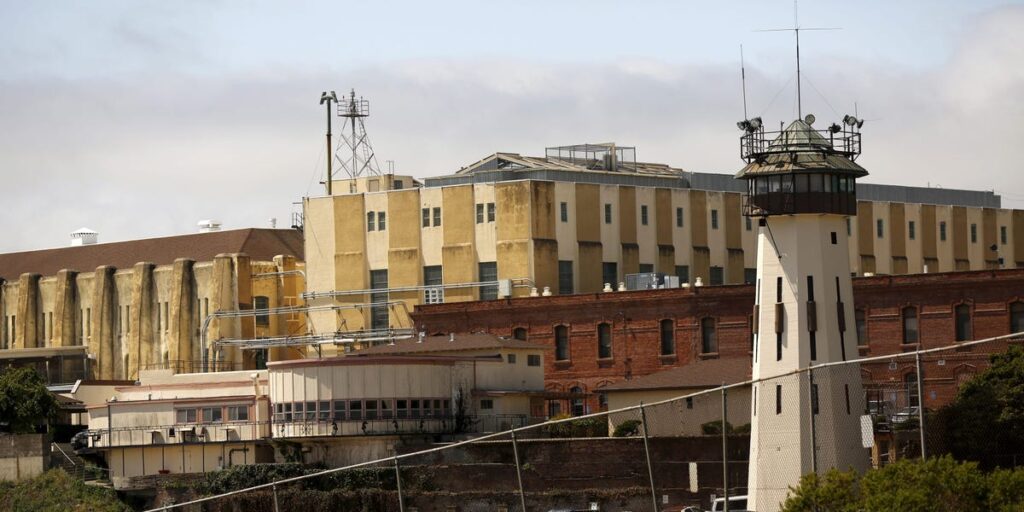Usually, when “chicken hindquarters” is on the dinner menu at San Quentin, it’s good news.
“It’s a very popular meal in prison,” Aaron Ramzy, who is incarcerated there, told Business Insider in a phone call from his cell unit Wednesday. “You get one piece of chicken, roasted on the bone.”
But last Wednesday, the welcome dish may have led to a very unwelcome result. Four men serving sentences at San Quentin say dozens of prisoners were sickened, and some 2,000 were subjected to a week of lockdown to prevent any illness from spreading.
Only on Wednesday, a full week later, were some units being taken off lockdown, they said.
In a written statement, a spokesperson for California Correctional Health Care Services confirmed that “a potential gastrointestinal illness” had resulted in a precautionary cut-back in “programming and visitation.”
But the officials would not confirm any specifics, and said the cause was still under investigation.
The four men who spoke to Business Insider told similar stories.
It all started, they said, with some gnarly chicken served the day before the 4th of July holiday.
“Normally, it’s prepared in the oven until it’s well done,” said Ramzy, 34. This chicken, though, was white with translucent skin. He said it looked undercooked.
“Hey, what is this?” Ramzy said he asked a correction officer who worked in the kitchen, which serves some 2,000 prisoners. The officer, he said, only shrugged.
“‘Enjoy your food,'” Ramzy said he was told.
In the four days after eating the chicken, he said he suffered “sweats, trembling, shivering,” along with even more unpleasant symptoms of diarrhea and dry-heaving.
“Oh, you ate that chicken?” he recalled officers telling him, as he lurched toward the prison medical facility. “Go ahead, go ahead and get to medical.”
Ramzy said a sergeant told him some three dozen fellow residents of the prison’s 600-inmate South Block needed medical attention, including electrolytes and antacids.
Luis Sigueras, 61, said he was rushed out of the prison to Marin General Hospital.
“Yes, I did eat the chicken, and I have other health problems,” including heart trouble, he told Business Insider.
“They took an EKG and a CAT scan and said I had food poisoning. It was the chicken on the bone from Wednesday — they served it with mashed potatoes and cake for dessert,” he said.
A doctor told him, “The next time you come here with chest pains or food poisoning, your heart is so weak you might not make it,” he said.
“I told him, ‘Doctor, if I gotta go, I gotta go. If God wants me, he’ll take me.'”
Marty Zahorik, 74, said he, too, was sickened after eating last Wednesday’s chicken. He was put on an IV and couldn’t keep water down.
“Everybody said I looked like I was going to die,” he said.
Zahorik said prison medical personnel told him 72 prisoners were treated for severe food poisoning.
“The food has been on a consistent downhill slide in the 22 years I’ve been here,” he said. Portions have shrunk to subsistence levels, condiments and other extras have vanished, and for years, there’s been a pigeon problem, he said.
Zahorik said as recently as Wednesday, he witnessed bird droppings on tables and broken windows in the kitchen.
About three years ago, the infestation was so bad, “We got a new sergeant, and he had a bunch of officers bring in pellet guns. And they executed the pigeons,” he said.
San Quentin is California’s oldest and most notorious prison. First built in 1852, it has survived waves of controversy.
The state is facing four lawsuits stemming from the 2020 transfer of prisoners infected with COVID-19 to the prison — and the coronavirus outbreak that followed, sickening 75% of the population.
Ultimately, 28 prisoners and a correctional officer died.
The prison’s four cell blocks house some 3,000 people in total.
Last May, Gov. Gavin Newsom announced the facility’s “transformation” from San Quentin State Prison into San Quentin Rehabilitation Center, empowering an advisory council comprised of community leaders, prison staff, and program leaders to come up with recommendations to improve conditions.
On Tuesday, the prison staff served chicken again, said Ramzy. “It was like chicken chunks over rice, with some kind of marinara sauce,” he said.
He has no idea how well it was cooked or what it tasted like.
“I didn’t eat it. I was scared,” he said.
“I know I’ve done something wrong, and I’m paying my debt to society, but I’m also human,” he told Business Insider Wednesday afternoon, as the lockdown began to be lifted, unit by unit.
“I have a family who loves me. I shouldn’t be getting just anything on a tray. I shouldn’t be subjected to poison,” he said.
A spokesperson for the California Correctional Health Care Services issued this statement on Tuesday:
“We are currently investigating cases of a potential gastrointestinal illness at San Quentin Rehabilitation Center. When multiple patients in a housing unit present with symptoms consistent with a gastrointestinal illness, CDCR and CCHCS will take proactive measures to limit potential spread. This includes providing additional cleaning, education on proper handwashing procedures, and testing for potential causes.
“Results of testing can take multiple days. Additionally, programming and visitation can be limited as a precaution to prevent further spread.”
California Correctional Health Care Services did not respond to follow-up questions Wednesday.
Read the full article here
















